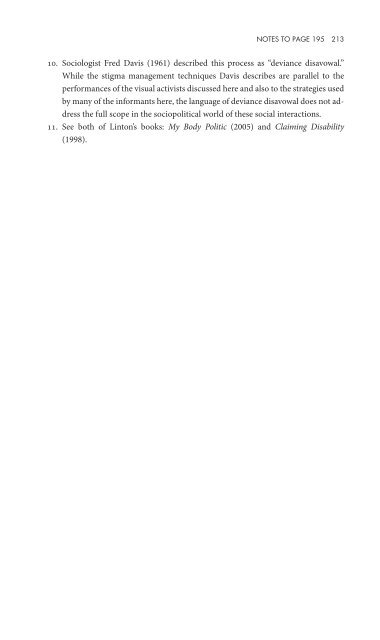Staring how we look sobre la mirada.pdf - artecolonial
Staring how we look sobre la mirada.pdf - artecolonial
Staring how we look sobre la mirada.pdf - artecolonial
You also want an ePaper? Increase the reach of your titles
YUMPU automatically turns print PDFs into web optimized ePapers that Google loves.
102 SCENES OF STARING<br />
and make sense of faces. As newborns, <strong>we</strong> learn very early to recognize our<br />
mother’s face. Adults can discriminate among thousands of faces. Our capacity<br />
to stare interpretively at faces is a fundamental form of social capital<br />
that enables human flourishing. People adapt facial recognition strategies<br />
to fit their situations. African Americans, for example, tend to develop superior<br />
emotion recognition compared to whites (Zebrowitz 1997, 28). The<br />
supposed intuition and emotional fluency of women may develop from their<br />
traditionally subordinated status. Blindness or low vision asks us to rely on<br />
alternative sensory clues that staring provides to the sighted. In contrast,<br />
certain brain injuries or conditions such as autism may inhibit people from<br />
recognizing emotion on another’s face, creating social disability. Prosopagnosia,<br />
a brain injury causing the inability to recognize faces, often prevents<br />
people from knowing they are being stared at and leaves them unable to<br />
sustain human re<strong>la</strong>tionships (McNeill 1988, 86). The staring re<strong>la</strong>tionship is,<br />
then, a central arena in which <strong>we</strong> recognize the inner lives of one another<br />
and are recognized in turn.<br />
The visual architecture of recognition—of distinguishing among faces<br />
and their meanings—abounds with challenges. Constancy and homogeneity<br />
pose problems for visual perception of faces. What cognitive psychologists<br />
call the “object constancy problem” involves the difficulties in<br />
recognizing objects as perspective, lighting, distance, and other contextual<br />
factors change over time (Rhodes and Tremewan 1994). In other words,<br />
<strong>how</strong> do I know my mother both when I am at her breast and when she<br />
is across the room chatting with her friends? Moreover, <strong>how</strong> can I know<br />
my mother both when she is <strong>la</strong>ughing and frowning? The “homogeneity<br />
problem” arises in visual cognition when objects share a configuration. The<br />
visual patterning of faces is very simi<strong>la</strong>r. What makes a face a face is its<br />
regu<strong>la</strong>rity, its predictable shape, allocation, and arrangement of features. In<br />
philosophical terms, homogeneity determines the face’s essence. Our cognitive<br />
task is to differentiate among simi<strong>la</strong>r configurations, to recognize<br />
a face as a face but also as a specific face. Reading and recognizing faces<br />
demands negotiating bet<strong>we</strong>en the universal and the particu<strong>la</strong>r, bet<strong>we</strong>en the<br />
parts and the whole. The problem of the typical face is recognizing it as a particu<strong>la</strong>r<br />
face. The problem of the distinctive face is recognizing it as a face. The<br />
problem of the distinctive feature is <strong>how</strong> it affects perception of the whole.<br />
The problem of the facial gestalt is <strong>how</strong> to find the nuances of individual<br />
features. The intense visual work of staring at faces is then both a cognitive<br />
and an epistemological undertaking. When <strong>we</strong> <strong>look</strong> at another person, <strong>we</strong><br />
seek to know much. Is this a face? Do I know this face? Whose face is this?<br />
Does this face know me? What is this face’s response to me? What does this<br />
face mean? Does this face matter to me? What re<strong>la</strong>tion do I have to this face<br />
now and what will it be in the future?


